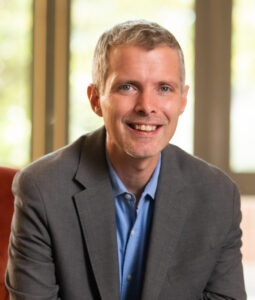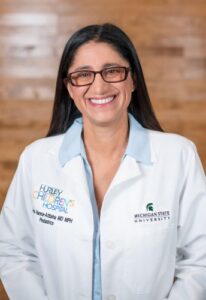U-M experts explore ramifications of housing crisis on economy, emotional well-being and more
Contact: Jeff Karoub, jkaroub@umich.edu; Matt Trevor, mtrevor@umich.edu
ANN ARBOR—The need for affordable and accessible housing is an issue that transcends political affiliation—even as it rises in significance to voters—and matters as much to our emotional and mental health as our financial well-being.
Two University of Michigan experts—Brian Connolly, assistant professor of business law, and Jennifer Erb-Downward, director of housing stability programs and policy initiatives at Poverty Solutions—appeared on the latest episode of the Business & Society podcast to discuss their research and thoughts on the housing crisis.
Throughout the discussion, they explored research and insights on the causes of the crisis, some adverse effects on the average American and its implications for the upcoming presidential election.
One major challenge facing the housing market is rent: Roughly 20 million renter-occupied households qualify as being cost-burdened by housing, meaning they spend about 30% of their pre-tax income on rent. Throughout the discussion, Connolly and Erb-Downward identify several factors contributing to this struggle.
They agree renters face challenges of quantity and quality. First, there are simply not enough rental properties. Second, many properties are still counted as rentable units despite their unlivable condition, giving policymakers and business leaders an inaccurate picture of supply.
“I think there’s also a misunderstanding, particularly in low-income communities, about the housing supply from the standpoint of quality,” Erb-Downward said. “We talk about the degradation of older housing and the loss of housing units. But then when we look at information, say from the census or other sources, a lot of times those older units will still be counted in that supply even if they are unlivable because we don’t have a good way of tracking livable housing—and that’s a really important piece of the equation when we’re thinking about people’s actual access to housing supply.”
Connolly said quality is not the only statistical anomaly in the housing crisis. Although 20 million renter-occupied households meet the 30% of income rent-burdened status, a significant portion of that population uses more than 50% of their income on housing costs.
This shows that skyrocketing rent prices are affecting a large population of Americans more than the reporting would have policymakers and business leaders believe.
Erb-Downward notes such extreme housing cost burdens have some detrimental effects on mental health, education outcomes and social-emotional development. Particularly as the largest group of people experiencing homelessness and nonpermanent housing are children.
Connolly says housing is usually more of a local political concern. However, as recently shown in the Michigan Ross Financial Times poll, it’s more significant in this election than in years past.
“If there is any bipartisan issue, it might be housing right now because when we look across the country, and we see actions that different states are taking and whether it’s a red or a blue state, they look fairly similar,” he said. “It just goes to show how nationalized this issue has become.”
The episode closes with a discussion on the increased cost of living in major cities like New York, Los Angeles and Chicago. The cost of living challenges that have struck these cities serve as a warning for cities like Detroit and Ann Arbor.
The panel discusses how the lessons of cost-of-living increases, gentrification and real estate development can shape the future of urban planning, the real estate industry and public policy locally and nationally.
Business & Society is co-produced by JT Godfrey of the Ross School of Business and Jeff Karoub of Michigan News, and hosted by Karoub. The audio engineer is Jonah Brockman.
Survey shows how Detroiters’ mental health has changed since pandemic
Contact: Lauren Slagter, lslag@umich.edu; Jared Wadley, jwadley@umich.edu
DETROIT—Detroiters’ mental health-related symptoms have improved and largely stabilized since the peak of the COVID-19 pandemic, according to a University of Michigan report.
While the negative impacts of the pandemic on people’s mental health are well documented, less is known about the persistence of mental health problems after the lockdowns ended and the economy reopened.
U-M’s Detroit Metro Area Communities Study, with support from Poverty Solutions, surveyed Detroiters about their mental health from April 2020 through December 2023. Results from the representative survey are weighted to reflect Detroit’s population.
New analysis of the survey data shows that while substantial percentages of Detroiters still report experiencing symptoms of depression, anxiety or general worry, the numbers have largely stabilized in the post-pandemic period.
“Understanding how mental health changed during a time of crisis and since stabilized can help mental health practitioners better meet the needs of their communities,” said Lauren Chojnacki, research associate at DMACS, who authored the report, “The Mental Health of Detroiters Has Improved Since the COVID-19 Pandemic.”
Early in the pandemic, in April 2020, a majority of Detroiters (62%) reported experiencing anxiety, 47% reported feeling depressed and 46% reported feeling “general worry.”
By June 2020, 44% of Detroiters said they felt anxiety, and the percentage has remained relatively stable since then. Rates of depression dropped to 35% by August 2023 before spiking to 41% in December 2023. Feelings of general worry declined to 37% of Detroiters in June 2020, and the rate has remained relatively stable since then.
The drop in depression, anxiety and worry since the peak of the pandemic applied to Black, white, and Latino Detroiters. Women generally were more likely than men to report experiencing poor mental health one or more days a week.
Detroiters with low incomes (annual household income under $10,000) consistently report higher rates of anxiety, depression and general worry than residents with annual household incomes of $100,000 or higher.
Residents under age 30 generally have higher rates of depression, anxiety and worry than Detroiters over 65, and this persisted from the peak of the pandemic in April 2020 through December 2023.
Report: The Mental Health of Detroiters Has Improved Since the COVID-19 Pandemic
Housing crisis in Michigan: Report explores who owns, rents, has no home; examines racial gaps
Contact: Kim North Shine, kshine@umich.edu
ANN ARBOR—The burgeoning housing crisis affecting Michigan and much of the nation is addressed in a new report by the University of Michigan in partnership with the Michigan State Housing Development Authority.
“The data in the report reveals a landscape of critical challenges and opportunities in supply, demand, quality, affordability and stability,” said Roshanak Mehdipanah, an associate professor at U-M’s School of Public Health and director of Housing Solutions for Health Equity, whose team gathered and analyzed the data.
“Against the backdrop of COVID-19 recovery, rising concerns over nationwide housing unaffordability and insecurity add urgency to our state’s housing discourse.”
The challenges remain especially profound for Black Michiganders who are part of a stark 34-point gap in home ownership that has 79% of white households owning their home compared to just 45% of Black households—one of many findings that highlight racial disparities.
“This is a clear indication that systemic inequalities need to be addressed,” Mehdipanah said. “Addressing racial inequities in homeownership is critical in closing the racial wealth gap, as homeownership serves as an important means for intergenerational wealth accumulation and stability, offering families the opportunity to build equity, access credit and secure financial futures.”
The report, “2024 Michigan Statewide Housing Needs Assessment,” delves into a decade of data around the complexities of housing availability, affordability and accessibility—information city officials, urban planners, county commissioners, the public and anyone working in housing or in housing solutions can use to make informed decisions.
To that end, the report also details case studies that “highlight local innovations that respond to some of Michigan’s housing challenges.” Each case study features a housing-focused organization’s success story.
“Data such as reduction in tax foreclosure rates tells us there is promise in housing-focused interventions, particularly those developed and implemented with community organizations working closely with residents on these issues,” Mehdipanah said.
David Allen, manager of the Office of Market Research at the Michigan State Housing Development Authority, said the intent of the assessment is to “provide pivotal data and analysis on a wide range of factors that impact Michiganders’ ability to obtain necessary shelter.”
“It can be used by a variety of stakeholders in the state’s housing ecosystem to better target resources and efforts to ensure that our families and individuals can enjoy a secure home, better health and a more inclusive economy,” he said.
In addition to Allen and Mehdipanah, who is also co-lead for the Public Health IDEAS for Creating Healthy and Equitable Cities initiative, other authors of the report include U-M Housing Solutions for Health Equity team members. Kate Brantley is a research area specialist, whose work focuses on housing stability and eviction, and Melika Belhaj is the program manager whose research has focused on foreclosure, speculator behavior, naturally occurring affordable housing and low-income home ownership program outcomes in Detroit.
The group presented the report at the Building Michigan Communities conference this week.
“Our findings confirm what many already know—Michiganders with the lowest incomes disproportionately face the greatest barriers to securing safe and affordable housing,” Belhaj said. “Our analysis reveals a 34-percentage-point homeownership gap between Black and white households, underscoring the lasting impact of U.S. housing policies, such as redlining, which imposed racialized segregation in the housing market.”
The report is divided into four sections: housing inventory, housing demand, housing affordability, and housing instability and homelessness. Each section weaves in eight priority areas: equity and racial justice, housing ecosystem, preventing and ending homelessness, housing stock, older adult housing, rental housing, homeownership and communication and education.
In addition to examining data across a 10-year timespan, the analysis focuses on the years 2017, 2019, 2021 and 2022. According to the report, “these years mark pivotal points in the housing ecosystem: 2017, nearly two years after the tax foreclosure crisis began to subside; 2019, the year before the global COVID-19 pandemic; 2021, during the height of the pandemic; and 2022.”
Key findings include:
- In 2022, 32,589 individuals were identified as experiencing homelessness, up 8% from 2021.
- Eviction filings increased by 38% between 2021 and 2022, after a significant drop in filings in response to the COVID-19 pandemic.
- Homeowners’ median household income was just over $80,000, higher than the statewide median at $67,000, while renters’ median household income of $39,000 was significantly lower than both the statewide and homeowner average.
- In 2022, 51% of renters were housing-cost burdened, or spending more than 30% of income on housing. This includes 26% of renters who were severely housing-cost burdened, or spending more than half of income on housing.
- Among homeowners, 24% with mortgages and 14% without mortgages are housing cost-burdened.
61% of all housing units were built before 1980. The federal government banned lead-based paint in homes in 1978, meaning the majority of housing units across the state today are at high risk of exposing tenants to lead and its risks to health, especially for children. Nationally, the number of homes built before 1980 is at 49%.
More positive findings include:
- From 2012 to 2022, Michigan experienced a notable 50% surge in median home values, now standing at $224,400.
- From 2019 to 2021, 25- to 34-year-olds in Michigan saw higher gains in the number of people heading households, compared to their younger and older counterparts. This change likely reflects life stages or milestones common among this age, including increased cohabitation, marriage and child rearing.
- Rising household growth among 25- to 34-year-olds may have been influenced by federal stimulus checks and student loan repayment pauses during the pandemic which provided opportunities to live independently as renters and homeowners.
- In 2022, the median household income across renter- and owner-occupant households jumped from $40,683 annually for those under age 25 and to nearly $76,000 for those aged 25-44.
- From 2012-2022, building permits for new construction of multifamily dwellings increased 4.4 times and made up 26% of total permits allotted, a departure from the state’s historical pattern of predominantly single-family structure construction.
The research was funded in part by a $50,000 grant from U-M’s Office of the Vice President for Research under the Bold Challenges Initiative, which supports research that applies a health equity lens to housing issues such as unaffordability, inaccessibility and quality. Other support comes from the U-M Poverty Solutions and the MICHR PACE grant.
Student Research Assistants – Real world experience in evidence-based poverty research and solutions
Contact: Karissa Knapp, ktknapp@umich.edu
The mission at Poverty Solutions is to partner with communities and policymakers to find new ways to prevent and alleviate poverty through action-based research. A key player in this work is University of Michigan students. Poverty Solutions research assistants (RAs) are a crucial part of the team and the work Poverty Solutions does. They work side-by-side with Poverty Solutions researchers on important projects like the Guaranteed Income to Grow Ann Arbor (GIG A2) pilot, Prosecutor Transparency Project, Flint Rx Kids, Detroit Financial Well-being Innovation Project, Investing in Us, and the Washtenaw County Opportunity Index. This last year (2023-4), 62 RAs aided Poverty Solutions work.
“The students who worked on the Guaranteed Income to Grow Ann Arbor Pilot were instrumental to the successful launch and were really the public face of the project,” said Kristin Seefeldt, associate faculty director for educational programs at Poverty Solutions. “They helped people navigate the project’s application process, checked documentation, and onboarded participants once the project was up and running. A number are working with us on the research portion of the project. We’ve received extremely positive feedback from residents and program participants about them, reminding us just how important students are to our mission.”
Through working together, Poverty Solutions also hopes to give RAs quality research experience and guidance as they figure out where they may want to go next in their career and what kinds of research they may be interested in doing.
“Research assistantships at Poverty Solutions have been a launching pad for students from across the university to careers in policy, research, nonprofit, and government work,” said Trevor Bechtel, student engagement and strategic projects manager of Washtenaw County Programs at Poverty Solutions. “Students bring a variety of specialized skills from their coursework and previous life experiences and build those skills, learning new ones while they expand our capacity, and form the engine for some of the larger projects we’ve undertaken.”
Poverty Solutions research assistants come from many schools and colleges across the university, from engineering to social work, design to medicine, business to public policy, and undergrad through post doc. Having such a range of students with different insights and knowledge involved in Poverty Solutions’ work allows more unique ideation and problem solving to tackle the challenges being researched. Below are some conversations from the RAs about their experiences at Poverty Solutions, and where they may want to go next:
What skills did you learn/grow while at Poverty Solutions?
 “I’ve worked on some research projects before this, but GIG A2 was my first experience with launching a research project. It is such a complicated process and I have so much respect for everyone on the team who was trying to plan for all of the unknowns!”
“I’ve worked on some research projects before this, but GIG A2 was my first experience with launching a research project. It is such a complicated process and I have so much respect for everyone on the team who was trying to plan for all of the unknowns!”
– Jaymie Tibbits, Social Work, 2nd year; GIG A2
 “I have some experience in doing implementation on the analysis side, and this was an excellent opportunity to learn and take part in the process earlier in the research pipeline. Being able to take part and help with the logistics and public-facing aspects of enrollment into this kind of research study was really valuable for me.”
“I have some experience in doing implementation on the analysis side, and this was an excellent opportunity to learn and take part in the process earlier in the research pipeline. Being able to take part and help with the logistics and public-facing aspects of enrollment into this kind of research study was really valuable for me.”
– Francisco Brady, Public Policy, 1st year; GIG A2
 “I also developed in learning how to exist in a role in a very large team. I understand more thoroughly the importance of clear and frequent communication with time-sensitive issues.”
“I also developed in learning how to exist in a role in a very large team. I understand more thoroughly the importance of clear and frequent communication with time-sensitive issues.”
– Andrew Wylie, Social Work, 1st year graduate student; Keep It Home
How did your work at Poverty Solutions develop or change your career interests?
 “I’m interested in policy and legislation, and this experience has really reaffirmed my belief that it’s so important to talk to people about their lived experiences. Many folks I spoke with expressed that they just feel really stuck in their current financial situation. I think as policymakers, we need to be paying more attention to the fact that it is really debilitating to feel like you have no room for mobility in your life. I think that despondence bleeds into many other areas of the health and well-being of people and communities.”
“I’m interested in policy and legislation, and this experience has really reaffirmed my belief that it’s so important to talk to people about their lived experiences. Many folks I spoke with expressed that they just feel really stuck in their current financial situation. I think as policymakers, we need to be paying more attention to the fact that it is really debilitating to feel like you have no room for mobility in your life. I think that despondence bleeds into many other areas of the health and well-being of people and communities.”
– Jaymie Tibbits, Social Work, 2nd year; GIG A2
 “[It] made me more interested in working with an organization like Poverty Solutions and/or becoming a researcher. I still have a strong interest in poverty alleviation and homelessness, so it is interesting to see how all the different Poverty Solutions projects target different facets of economic and personal well-being.”
“[It] made me more interested in working with an organization like Poverty Solutions and/or becoming a researcher. I still have a strong interest in poverty alleviation and homelessness, so it is interesting to see how all the different Poverty Solutions projects target different facets of economic and personal well-being.”
– Sadie Mrakuzic, Social Work, 1st year; GIG A2
 “My experience with SummerWorks has motivated me to explore avenues for promoting equity and youth empowerment in my future roles. As an MBA candidate at the Ross School of Business, we often talk about social impact and discuss how we can be leaders in our future jobs. … I’ve come to appreciate that impact extends beyond monetary measures. It involves providing tangible skills and opportunities that can profoundly alter the trajectories of youth in the communities we serve. Whether advocating for our firms to participate as employers or stepping up as mentors, there are meaningful opportunities to make a difference in young adults’ lives and pave the way for their success.”
“My experience with SummerWorks has motivated me to explore avenues for promoting equity and youth empowerment in my future roles. As an MBA candidate at the Ross School of Business, we often talk about social impact and discuss how we can be leaders in our future jobs. … I’ve come to appreciate that impact extends beyond monetary measures. It involves providing tangible skills and opportunities that can profoundly alter the trajectories of youth in the communities we serve. Whether advocating for our firms to participate as employers or stepping up as mentors, there are meaningful opportunities to make a difference in young adults’ lives and pave the way for their success.”
– Dominique Downs, MBA candidate, Class of 2024; SummerWorks
What would you say to students interested in working with Poverty Solutions? Or any general advice to those interested in research in this space?
 “Being an RA at Poverty Solutions is a great opportunity for professional growth. The researchers there are doing impactful work and you can be a meaningful part of it. I think it is a great way to get your foot in the door if you are interested in doing research in this space, since it is a well-known research hub. The Principal Investigator I worked for made sure that we were engaged at every part of the process and learned valuable skills. From data cleaning to interacting with participants, we had adequate training to feel empowered to handle each step. I would recommend it to anyone motivated to do research for social good.”
“Being an RA at Poverty Solutions is a great opportunity for professional growth. The researchers there are doing impactful work and you can be a meaningful part of it. I think it is a great way to get your foot in the door if you are interested in doing research in this space, since it is a well-known research hub. The Principal Investigator I worked for made sure that we were engaged at every part of the process and learned valuable skills. From data cleaning to interacting with participants, we had adequate training to feel empowered to handle each step. I would recommend it to anyone motivated to do research for social good.”
– Sadie Mrakuzic, Social Work, 1st year; GIG A2
 “I would say that working at Poverty Solutions is a good option for students who are looking to gain exposure to interdisciplinary research and access to researchers who are passionate about honoring and centering the communities they research. My general advice to everyone starting a research position is don’t be afraid to ask questions, nobody will bite!”
“I would say that working at Poverty Solutions is a good option for students who are looking to gain exposure to interdisciplinary research and access to researchers who are passionate about honoring and centering the communities they research. My general advice to everyone starting a research position is don’t be afraid to ask questions, nobody will bite!”
– Francisco Brady, Public Policy, 1st year; GIG A2
 “I would advise anyone interested in working in this research space to come with an open heart and a curious mind. The research team I worked with was incredibly thoughtful and took a lot of care setting up the study in a way that centered the participants’ unique experiences. There was a very clear distinction from the start that the participants we would be working with are PEOPLE first. Poverty Solutions really embodies how I think all researchers should approach their work, with an inclusive focus on the lives of those they are trying to learn from. Lastly, I was so proud to work on a project that was designed to intentionally disrupt some of the bureaucratic systems that act as barriers to autonomy for many people living in poverty. This experience helped me to envision a system of social services rooted in justice and respect, to use as a blueprint for the future.”
“I would advise anyone interested in working in this research space to come with an open heart and a curious mind. The research team I worked with was incredibly thoughtful and took a lot of care setting up the study in a way that centered the participants’ unique experiences. There was a very clear distinction from the start that the participants we would be working with are PEOPLE first. Poverty Solutions really embodies how I think all researchers should approach their work, with an inclusive focus on the lives of those they are trying to learn from. Lastly, I was so proud to work on a project that was designed to intentionally disrupt some of the bureaucratic systems that act as barriers to autonomy for many people living in poverty. This experience helped me to envision a system of social services rooted in justice and respect, to use as a blueprint for the future.”
– Jaymie Tibbits, Social Work, 2nd year; GIG A2
If you’d like to learn more about student opportunities at Poverty Solutions, please visit our student page for more information on the Poverty Solutions certificate and research opportunities, or email Trevor Bechtel at betrevor@umich.edu.
Interested in more? Sign up for the Poverty Solutions Student Newsletter – be sure to indicate “Student Involvement.”
New Michigan poverty map identifies needs related to education, food insecurity, affordable housing
Contact:
Karissa Knapp, ktknapp@umich.edu
Jared Wadley, jwadley@umich.edu
ANN ARBOR—A new data map showcasing diverse indicators of poverty and well-being throughout Michigan highlights the key challenges confronting residents in different parts of the state and suggests interventions for the state’s most critical needs.
Poverty Solutions at the University of Michigan has released an updated version of its Michigan Poverty & Well-being Map with statewide, regional and county data. The new iteration of the map, which Poverty Solutions has maintained since 2017, features 2021 data from the Census Bureau’s American Community Survey.

Luke Shaefer, Director of Poverty Solutions at U-M
The revised map separates the data by Michigan’s 10 Prosperity Regions, which allows viewers to look at the unique dynamics at play in different areas of the state.
“The poverty rate alone doesn’t give us a complete story of how many people are facing economic instability and hardship. The Michigan Poverty & Well-being Map looks at multiple metrics to give us a more holistic idea of how Michiganders are doing,” said Poverty Solutions faculty director Luke Shaefer, professor of social work and public policy.
Some key metrics from the data include:
- 13% of Michiganders were living on income below the federal poverty line, which is about the same as the previous year. The national poverty rate is 11.5%.
- 17.6% of children under age 18 were in households below the federal poverty line.
- 31.3% of residents paid 30% or more of their income on housing costs, which is above the threshold of what’s considered affordable.

Amanda Nothaft, Director of Data and Evaluation at Poverty Solutions
“The disparities highlighted by the map can inform how state and local officials address these issues and where to invest resources to support their residents, their region and the state,” said Amanda Nothaft, director of data and evaluation at Poverty Solutions, who led the data analyses for the map project.
Investing in education, for example, by expanding preschool programs and providing additional training beyond high school, is one recommendation Nothaft makes. This kind of funding for education could improve employment prospects and economic well-being in the state, she says. Other areas of need illustrated by the data include food insecurity, affordable housing, child poverty, child care, unemployment and income.
Learn more about each region’s challenges by viewing the regional fact sheets:
- Detroit Metro: High Housing Costs Burden Residents
- East Michigan: Investment in Education Can Boost Wages
- East Central Michigan Sees High Rates of Food Insecurity, Despite High Rates of Food Assistance
- Northeast Michigan Faces Highest Child Poverty Rates in the State
- Northwest Michigan: Tight Housing Market Puts Cost Burden on Renters
- South Central Michigan: Investing in Education in Lansing Can Boost Economic Well-being
- Southeast Michigan: Racial Disparities Underlie Strong Economic Position of Residents
- Southwest Michigan: Many Residents Are Above the Poverty Line But Still Struggling
- Upper Peninsula Residents Face Cost of Living Challenges
- West Michigan Should Invest in Addressing Poverty in Lake County
How do we measure poverty?
Nothaft explains measurements used at Poverty Solutions and in the Michigan Poverty & Well-being Map.
Poverty Solutions at U-M grows partnerships in poverty alleviation in 2023
Contact: Lauren Slagter, lslag@umich.edu
Poverty Solutions at the University of Michigan last year informed the largest-ever increase in state funding for youth homelessness programs, advised federal policymakers on place-based strategies for tackling poverty and laid the groundwork for innovative cash assistance programs.
These policy impacts and other accomplishments from the past year at the national, statewide, local and campus levels are outlined in the presidential initiative’s 2023 impact report, which was released Feb. 1.
Strong partnerships with policymakers, community groups and academic scholars are instrumental in driving Poverty Solutions’ progress in using action-based research to successfully alleviate poverty.
“There are many ways to gauge impact, but the ultimate measure is whether we are positively impacting people’s lives in meaningful ways,” said H. Luke Shaefer, founding faculty director of Poverty Solutions, which launched in 2016.
“That type of impact is only possible through partnerships, and we continue to build relationships with policymakers and practitioners to ensure our research is responsive to the pressing issues of the day.”
Shaefer also is the Hermann and Amalie Kohn Professor of Social Justice and Social Policy and a professor of public policy in the Gerald R. Ford School of Public Policy, and a professor of social work in the School of Social Work.
Faculty from various fields, 139 students from 17 of U-M’s 19 schools and colleges, plus 14 staff members contributed to Poverty Solutions’ work last year. That included hosting 16 events exploring the causes and consequences of poverty; supporting the publication of 17 academic journal articles, working papers and policy briefs; and garnering more than 500 mentions in national, regional and local news outlets.
“Part of our mission at Poverty Solutions is to foster a highly interdisciplinary approach to confronting poverty. We cultivate relationships with faculty and students across the university to build a collaborative learning community that can bring new ideas to fruition,” said Kristin Seefeldt, associate faculty director of Poverty Solutions and an associate professor of social work and public policy.
Policy impact highlights include:
- Laying the groundwork for cash assistance programs that will launch in 2024 and serve as blueprints for child allowance and guaranteed income programs across the country. These include Flint Rx Kids, a citywide maternal and infant cash prescription program, and Guaranteed Income to Grow Ann Arbor, which provides guaranteed income to 100 entrepreneurs and gig workers with low incomes in Ann Arbor.
- Informing a $5.3 million boost in state funding for youth homelessness programs, which was the largest increase in funding for youth homelessness prevention and intervention services in the history of Michigan’s state budget.
- Providing technical assistance to organizations involved in the Detroit Financial Well-Being Innovation Challenge.
- Advising federal policymakers on place-based approaches to poverty alleviation, which Poverty Solutions is pursuing in partnership with community organizations across the country.
The impact report also spotlights Poverty Solutions’ efforts to make data more accessible on food security and opioid use, support faculty research on transportation insecurity, shed new light on barriers to affordable and accessible child care in Michigan, explore public opinion on reparations, and promote workforce preparation for local young adults.
“The diversity of our projects reflects the ways housing, education, the labor market, child care and other broad systems intersect. This is why collaborative, interdisciplinary approaches to solutions are so vital,” Shaefer said.
5 things to know about Flint Rx Kids
Rx Kids launch press conference on Wednesday, Jan. 10, 2024, at Hurley Medical Center in Flint. From left to right: Mama Sol, Ridgway White, Luke Shaefer, Governor Gretchen Whitmer, a Flint mom, Alana Turner, Mona Hanna-Attisha, Teresa Woodruff, Sheldon Neeley, a Flint mom, Day Austin, and Jim Ananich. (Courtesy of Governor Whitmer’s office)
Contact: Karissa Knapp, ktknapp@umich.edu
Flint, MI – Today City of Flint pregnant moms and newborns can start enrolling in Rx Kids, the first citywide maternal and infant cash prescription program in the nation. Joined by Mayor Sheldon Neeley, Michigan State University Interim President Teresa Woodruff, Charles Stewart Mott Foundation President Ridgway White, and Rx Kids families and newborns, Governor Gretchen Whitmer kicked off the historic launch at Hurley Children’s Hospital in Flint.
“This will give every new mom in Flint the freedom and flexibility to raise their babies without worrying about how to pay their bills and put food on the table … I do believe that this is… the kind of investment that you can see return on over the course of a lifetime. I believe this particular investment is one that others will seek to emulate when they see the difference it can make,” said Whitmer.
Rx Kids is led by partners Dr. Mona Hanna-Attisha, associate dean for public health and C. S. Mott Endowed Professor of Public Health at MSU College of Human Medicine, and Luke Shaefer, director of Poverty Solutions at the University of Michigan and the Hermann and Amalie Kohn Professor of Social Justice and Social Policy. Rx Kids will help families make ends meet and provide a solid start for their child.
>> Read more about the press conference
Here are five things to know about the Flint Rx Kids program:
1. What is Flint Rx Kids?
Rx Kids is a program that “prescribes” cash payments to every expectant mother and infant in the city of Flint, Michigan, with the goal of improving infant and maternal health, the economic and mental well-being of participants, and community-wide outcomes.
2. Who is eligible, and what will they receive?
City of Flint residents who are at least 20 weeks pregnant or who have a baby born in 2024 can apply to receive these no-strings-attached monthly payments. Applications are processed on a rolling basis, and participants will receive a $1,500 payment during pregnancy and $500 per month during the infant’s first year. There are no income requirements. Documents applicants will need to provide include: proof of identity, proof of residency, and proof of being 20+ weeks pregnant or guardianship. Learn more and apply online at FlintRxKids.com.
3. What does the research say about the impact of unconditional cash assistance?
Hundreds of studies show that unconditional cash transfers can be life-changing across countries and contexts. Mothers and babies are no different, and early intervention is shown to have sustained health and development impacts years after cash is delivered. Multiple studies have found positive impacts of cash on pre and post natal health, including: birth weight, premature births, breastfeeding, parental mental health, and food security. New research also shows that $333 monthly cash transfers to families with low incomes boosted infants’ early cognitive development. Furthermore, these impacts can last into adulthood. Years after their moms received cash transfers, adult children experienced benefits across health, education, nutrition, lifetime earnings, and reduced anxiety and depression.
.@UmichPoverty Director @ProfShaefer is co-director of Rx Kids with @MonaHannaA and a leading scholar on cash assistance. #FlintRxKids pic.twitter.com/Oq8cKYHVQm
— University of Michigan Poverty Solutions (@UmichPoverty) January 10, 2024
4. Where is the money coming from?
Thanks to our incredible funders, Flint Rx Kids has raised over $43 million as a public-private partnership. This includes an $15 million challenge grant from the Charles Stewart Mott Foundation, a $1 million allocation from the Flint City Council’s American Rescue Plan Act funds, and $16.5 million from the State of Michigan’s Temporary Assistance for Needy Families block grant (TANF), among other donors. The hope is to have the program run as long as possible; current funding commitments will enable the program for at least three years. A $55 million total investment is needed to fund five years of Rx Kids. Please visit the Rx Kids website for more information on funding and how you can help.
5. How do I stay in the loop about Flint Rx Kids?
Check out the news page on the Flint Rx Kids website for the latest stories. You can follow Flint Rx Kids on Facebook and Instagram. Finally, save the date for the “The All We Need is Love” Rx Kids Launch Bash on Feb. 14 at 7 p.m. at the Capitol Theatre, in Flint. More details to come!
For questions about Rx Kids, please visit their FAQ page and/or email support@rxkids.zendesk.com.
Enrollment Open: Flint Makes History with Launch of Rx Kids
FLINT, Mich. – On January 10, 2024, at 10 am, City of Flint pregnant moms and newborns will start enrolling in Rx Kids, the first citywide maternal and infant cash prescription program in the nation.
Joined by Mayor Sheldon Neeley, Michigan State University Interim President Teresa Woodruff, Charles Stewart Mott Foundation President Ridgway White, and Rx Kids families and newborns, Governor Gretchen Whitmer will kick off the historic launch at a 10:30 am press conference at Hurley Children’s Hospital. Flint musical icon Mama Sol will perform the world premiere of her new composition live, honoring the landmark program.
Rx Kids will begin to enroll every pregnant mom and newborn in the City of Flint – with no income restrictions or strings attached – empowering parents with the freedom and choice to make the decisions that best fit their families’ needs. Every mom will receive $1,500 during mid-pregnancy for food, prenatal care, rent, cribs, or whatever they need. After birth, families will receive $500/month for the baby’s first twelve months they can spend on needs such as formula, diapers, or childcare. The program holds the promise to eradicate deep poverty among families with infants in Flint.

Dr. Mona Hanna-Attisha.
Photo: Courtesy of MSU
Led by Flint pediatrician Mona Hanna-Attisha, MD, MPH, Associate Dean for Public Health in the College of Human Medicine and Director of the Michigan State University-Hurley Children’s Hospital Pediatric Public Health Initiative, Rx Kids is a prescription for health, hope, and opportunity.
“This first-in-the-nation initiative boldly reimagines how society supports families and children—how we care for each other,” says Dr. Mona. “Rx Kids embodies Flint’s can-do spirit of not only dreaming but also making what seems impossible a reality to ensure that every child will flourish. Rx Kids is powered by science and driven by community.”
Why Flint? The poorest city in the state and one of the poorest in the country, almost 70% of kids in Flint are growing up in poverty – 5x the U.S. average. Every year, around 1,200 children are born in Flint to families, many facing severe hardships. The prenatal and first months of life are critical for a baby’s current and lifelong health and development; it is also when families struggle most financially.
“Investing in strong families is an investment in Flint’s future,” Flint Mayor Sheldon Neeley said. “Thanks to Dr. Mona, Flint is leading the way on a transformational model of care for families that I hope will spread across our nation. Rx Kids will support mothers and children in Flint when they are most vulnerable. This blessing will lift families out of poverty and improve health outcomes. Our prayer is that we will improve maternal and infant health, and help Flint families raise strong, healthy babies.”
City of Flint residents who are pregnant or have a baby born as of January 1, 2024, can complete the brief mom-tested application online at FlintRxKids.com beginning January 10, 2024, at 10 am. To sign up, participants need only verify identity, residency, and pregnancy (at least 20 weeks) or guardianship. After verification, participants will receive a message outlining what to expect next. Cash prescriptions will begin at the point of enrollment. Enrollment support, including chat and call center information, and FAQs are available at FlintRxKids.com.
Rx Kids was developed in partnership with Flint parents, community organizations, and national experts. In addition to the MSU-Hurley Pediatric Public Health Initiative, Rx Kids partner organizations include University of Michigan Poverty Solutions, Greater Flint Health Coalition, and program administrator, GiveDirectly.
“For more than 13 years, GiveDirectly has helped give unconditional cash transfers to people in need across the country and around the world — we look forward to bringing that expertise to support families in Flint,” said GiveDirectly U.S. Country Director Dustin Palmer. “Research shows that cash support during pregnancy and infancy results in healthier pregnancies, improved early childhood development, and even sustained impacts into adulthood.”
As the first citywide program, robust research will evaluate the impact of Rx Kids on participant health and community-wide outcomes. Rx Kids aims to impact economic stability, housing and food security, health care utilization, maternal and infant health outcomes, child welfare, and family well-being and stress. Other potential impacts include community reinvestment, neighborhood safety, civic engagement, population stability, and societal savings.

Luke Shaefer, Director of Poverty Solutions
Rx Kids co-director, H. Luke Shaefer, professor of public policy and director of Poverty Solutions at the University of Michigan, highlighted the power of a transformational community-driven initiative that builds on worldwide evidence. “Countries across the globe have adopted unconditional child cash benefits and seen child poverty plummet and health improve, with some of the biggest impacts for infants. The historic 2021 expanded Child Tax Credit had the same effects in the U.S., but it was not renewed. Flint is leading the nation by building on this evidence, and creating an easy-to-replicate playbook for how we care for our youngest kids.”
A community-wide celebration of the Rx Kids is planned for Valentine’s Day (February 14, 2024). Free family-friendly activities and resources will be held at the Flint Children’s Museum from 10 am-4 pm. A love-filled evening Launch Bash at the iconic Capitol Theatre, produced by BeatsXBeers, will feature local and national talent including Flint Institute of Music, Mama Sol, David Blight, Semaj Brown, Feimstro, and more. For more information, tickets, and sponsorship opportunities, visit FlintRxKids.com.
A public-private partnership, Rx Kids is made possible thanks to major support from the Charles Stewart Mott Foundation and the State of Michigan. Other founding funders include the Skyline Foundation, Ruth Mott Foundation, City of Flint, Doris Duke Foundation, Jamie and Denise Jacob Family Foundation/Ajax Paving, Michigan Health Endowment Fund, Blue Cross Blue Shield of Michigan Foundation, Children’s Foundation, HAP CareSource, Community Foundation of Greater Flint, Mott Children’s Health Center Roy Peterson Fund and Jeremy and Amy Piper Fund at the Community Foundation of Greater Flint, Hurley Foundation, Max M. and Marjorie S. Fisher Foundation, and the generosity of individual donors. The project is estimated to cost $55 million for five years of newborns; over $43 million has been raised to date.
To learn more about Rx Kids, visit FlintRxKids.com and @FlintRxKids on Facebook and Instagram.
News release courtesy of Michigan State University.
Speaker series to cover reparations, human-centered design, health impacts of oppression
Contact: Karissa Knapp, ktknapp@umich.edu
ANN ARBOR—This fall, the Real-World Perspectives on Poverty Solutions Speaker Series will feature poverty experts in both policy and practice, who will explore critical issues like: the effects of systemic oppression on health, reforming public institutions through human-centered design, reparations, and financial empowerment in Detroit.
The series is hosted by Poverty Solutions at the University of Michigan, a university-wide presidential initiative that aims to prevent and alleviate poverty through action-based research.
U-M researcher Arline Geronimus, professor of health behavior and health education at the School of Public Health, will be starting the series on Friday, Sept. 22. Geronimus will share her research on the effects of systemic oppression on the body. Her book on the subject – Weathering: The Extraordinary Stress of Ordinary Life in an Unjust Society – came out earlier this year.
Poverty Solutions is partnering with various university departments to invite this diverse set of speakers to discuss different approaches to addressing poverty in this year’s seven-week series.
All events are free and open to the public, and will take place at noon on Fridays in room ECC 1840 at the School of Social Work, unless otherwise noted. U-M students can enroll in a course to earn one credit for attending the speaker series.
Here’s the speaker series lineup:
- Sept. 22 – “Weathering: The extraordinary stress of ordinary life in an unjust society” by Arline Gerominus, professor of health behavior and health education, School of Public Health, U-M.
- Sept. 29 – “The United States pays reparations every day—just not to Black America?” by Cornell William Brooks, Hauser Professor of the Practice of Nonprofit Organizations, professor of the practice of public leadership and social justice, Harvard University.
- Oct. 6 – “The power in a single story: Scaling social change by focusing on individuals” by Adam Selzer, co-founder and senior director of Civilla Detroit.
- Oct. 13 – “Chelsea Eats: Basic income and food security” by Jeff Liebman, director of the Taubman Center for State and Local Government; Robert W. Scrivner Professor of Social Policy, Harvard University.
- Special date and location: 12:30 p.m. Oct. 18 at the Michigan Union – “Incarceration and its aftermath: How art can create pathways to reintegration and healing” by Reuben Miller and Nicole Fleetwood, MacArthur Fellows. Miller is an associate professor of social work, University of Chicago, and Fleetwood is a professor of media, New York University.
- Oct. 20 – “Creating green energy and equitable enterprise in Detroit” by Jerry Davis, Gilbert and Ruth Whitaker Professor of Business Administration, professor of management and organizations, U-M Ross School of Business.
- Oct. 27 – “Creating moves to opportunity: Experimental and mixed methods evidence on neighborhood choice” by Stefanie DeLuca, James Coleman Professor of Sociology and Social Policy, Johns Hopkins University.
- Nov. 3 – Poverty Solutions alumni panel
Mapping poverty in America: Shaefer’s new book explores “The Injustice of Place”
Contact: Daniel Rivkin, rivkind@umich.edu
America is rife with “internal colonies,” where systemic violence, resource extraction, and corruption among decision makers have contributed to generations of poverty and disadvantage. These communities suffer from environmental degradation, lack of services, and shortened life expectancy, and they are spread across a wide swath of the country: from Appalachia, to the Tobacco Belt of Virginia and the Carolinas, the Cotton Belt in the South, and South Texas.
These areas are the focus of a new book by the Ford School’s Luke Shaefer, The Injustice of Place: Uncovering the Legacy of Poverty in America, (Harper Collins, August 2023) which links economic data, health outcomes, and local history and traditions. Shaefer, the Hermann and Amalie Kohn Professor of Social Justice and Social Policy and director of Poverty Solutions, co-authored the book with Kathryn Edin, a sociology professor, and Timothy Nelson, director of undergraduate studies in sociology, both at Princeton.
Shaefer and Edin previously collaborated on $2.00 a Day: Living on Almost Nothing in America (Mariner Books, 2016), which was a New York Times Notable Book of the Year.
The places highlighted in The Injustice of Place were identified by an Index of Deep Disadvantage developed by Shaefer, Edin, and Nelson. The index represents a holistic look at disadvantage, using health indicators (life expectancy, low infant birth weight), poverty metrics (rates of poverty and deep poverty), and social mobility data (Opportunity Insights Mobility Metrics).
The researchers found most of the 100 most disadvantaged places in the country are rural, not inner cities. They have spent years immersing themselves in communities in these regions, getting to know the residents.
- The communities they studied have common traits of unequal schooling, resource extraction, corruption, and bad governance.
- Among the similarities the authors present:
- When disasters such as tornadoes, hurricanes, or floods strike, governmental assistance often deepens pre-existing divides, benefitting the “haves” and not the “have-nots.”
- Many people think of rural America as predominantly white — but the most disadvantaged places in the nation are rural communities of color.
- Americans living in disadvantaged communities can expect to die a decade earlier than those living in the most advantaged places.
- In many rural places with the most significant levels of disadvantage, the rate of violent crime is equal to that of large cities like Chicago.
“We are now armed with new revelations about poverty and a new understanding of how deeply disadvantage is woven into the history and present-day fabric of particular places,” they write. The book “tells the stories of America’s internal colonies – where disadvantage has been endemic for generations – and calls us to envision a different future, where no corner of the country is left behind.”
See reviews of the book:
A powerful, alarming portrayal of how poverty remains entrenched in unfairly forgotten places across America, Kirkus Reviews
In America’s “internal colonies,” the poor die far younger than richer Americans, CBS News
